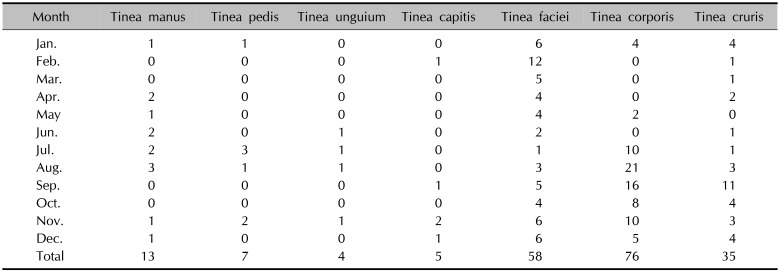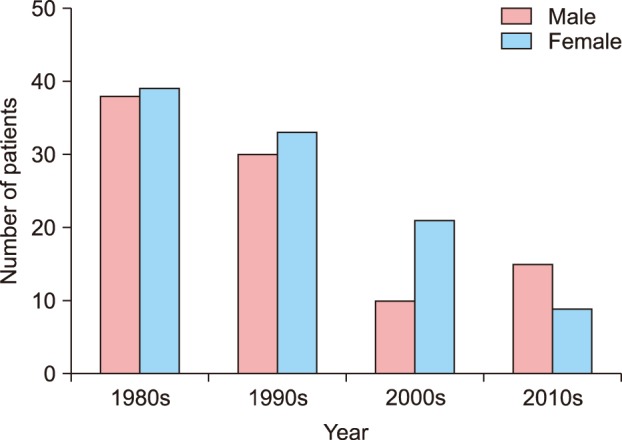INTRODUCTION
With immunocompromising hosts, the elderly, international exchange and economic development, the epidemiology of dermatophytosis has been changing worldwide. The epidemiological data on dermatophytosis in Korea also showed enormous changes.
Trichophyton schoenleinii was the most important causative fungus of tinea capitis in Korea in 1950s. However, it has not been found in Korea since 1980s. On the contrary,
Trichophyton tonsurans has been found as one of the causative factors of dermatophytosis in Korea since 1990s
1. Therefore, it is important to investigate the epidemiological and mycological changes of dermatophytosis for improving the personal health and storing the medical data.
Microsporum gypseum is a cosmopolitan geophilic dermatophyte, frequently found in contaminated soil. It usually causes an inflammatory superficial dermatophytosis in the scalp and glabrous skin in humans and rarely develops onychomycosis. However, its prevalence among dermatophyte infections is very low
23. Infection with
M. gypseum accounts for less than 0.19% of superficial dermatophytosis in Korea
4. In addition, there are few reports on the infection due to
M. gypseum in the literature. The aim of this study is to add massive data on
M. gypseum to the literature and to provide useful information on clinical and mycological characteristics of
M. gypseum.
Go to :

DISCUSSION
M. gypseum has been isolated from infected animal and especially contaminated soil worldwide. This has also been isolated from South Korea since 1966. However, the incidence of
M. gypseum infection is very low.
Trichophyton rubrum,
Trichophyton interdigitale,
T. tonsurans and
Microsporum canis have become the major species of dermatophytosis globally
5. Especially,
T. rubrum is the most common dermatophyte, accounting for 80% to 90% of all isolated dermatophytes
67. Romano et al.
3 reported that the incidence of dermatophytosis caused by
M. gypseum in Siena was 6.8% of all dermatophytic infections. They investigated 14 cases of
M. gypseum infection between 2004 and 2005. Sei
2 also conducted an epidemiological survey of dermatophytosis. The survey showed
M. gypseum was isolated from only 3 outpatients out of 36,052 outpatients. Only a few cases with
M. gypseum infection have also been reported in South Korea. The first two cases of
M. gypseum infection were published by Kim and Suh
8 in South Korea in 1976. After then, eight cases was investigated by Jun and Suh
9 in 1980. We retrospectively analyzed big data of 198 cases from 1979 to 2016. As reported in Italy and Japan, the annual incidence of
M. gypseum infection was very low. Although the incidence of
M. gypseum infection showed a decreasing tendency, it still remained around us.
When we began this study, it was expected that middle-aged adults living in rural area were most frequently infected, because they had always been working in the yards or gardens as farmers. On the contrary to our expectation,
M. gypseum was most frequently isolated in young children. Especially in 1980s, the incidence of
M. gypseum infection in young children was highest. Jun and Suh
9 also reported young children was the most common age group of
M. gypseum infection. In recent years, young adults were most frequently infected by
M. gypseum. Improvement of hygiene and easy accessibility to hospitals might lead the decrease in incidence of
M. gypseum infection in young children in recent years. On the other hand, Lee et al.
6 reported
T. rubrum was most frequently infected in the middle-aged group. It is written in the literature that
Trichophyton mentagrophytes was also most frequently infected in the middle-aged group
10. However, M. canis infection was usually developed in young children in South Korea
11. In addition, this report was published that
T. tonsurans infection occurred most frequently in the teenager group
11. Furthermore, it was reported that anthropophilic dermatophytes, such as
Trichophyton violaceum,
T. tonsurans and
Microsporum audouinii are causing outbreaks of small epidemics of tinea corporis and tinea capitis in young children and teenagers
12. The incidence of
M. gypseum infection was higher in women than in men out of our expectation. However, men were higher than women in the young children group.
Although tinea corporis was the most common clinical type of
M. gypseum infection, tinea cruris was most common in men. In addition, tinea faciei was the most common clinical type of
M. gypseum infection in young children and tinea cruris in teenagers. According to annual incidence, tinea faciei was most common clinical type of
M. gypseum infection in 1980s, but tinea corporis became the most common clinical type of
M. gypseum infection from 1990 to 2016. Improvement of hygiene, interest in beauty and health, and easy accessibility to hospitals might decrease in incidence of tinea faciei caused by
M. gypseum in recent periods. On the other hand,
Trichophyton rubum usually causes tinea pedis and tinea unguium
5.
Trichophyton metagrophytes also usually causes tinea pedis
9.
M. canis is a major cause of tinea capitis
5.
T. tonsurans is also an important cause of tinea capitis
5.
The incidence of
M. gypseum infection was highest in hot season including September and August. Interestingly, the incidence of tinea faciei caused by
M. gypseum was highest in February. It is found in the literature that
M. canis showed higher incidence in winter than in any other seasons
10.
T. tonsurans occurs commonly in the spring
11. However,
T. rubrum and
T. mentagrophytes usually develop dermatophytosis in hot season
89.
In conclusion, our study, including a lot of patients for a long period, will provide very useful information on dermatophytosis caused by M. gypseum in the field of medical mycology.
Go to :










 PDF
PDF ePub
ePub Citation
Citation Print
Print








 XML Download
XML Download